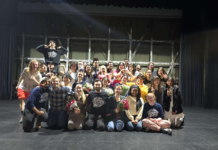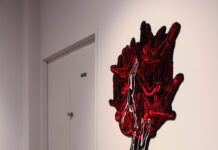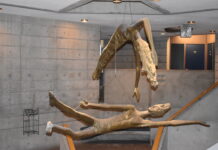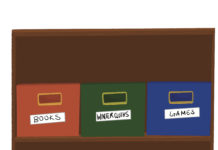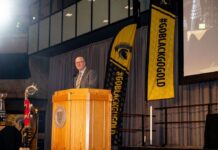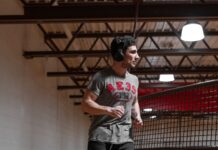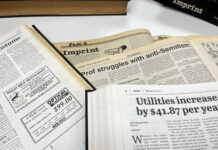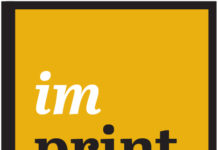The University of Waterloo is home to a variety of ambitious student organizations that aim to innovate campus life and administration. Among them is UW Blockchain, a club that works with and develops blockchain ecosystems (such as Web3), hosts events to help foster startups, and connects members with potential employers. Over the last several months, the club has been developing a blockchain system that they say, if fully adopted, could radically alter campus culture, transactions, and student government. They call it “GooseDAO.”
A blockchain is an immutable, secure database that records information (such as transactions) on a peer-to-peer network. GooseDAO is the name of one such network that is being spearheaded by two prominent members of UW Blockchain — Amy Qin, a chemical engineering student, and Evan Van der Meer, who is studying biology and Indigenous entrepreneurship. Their goal is to launch it on UW campus this term.
In September 2023, Qin presented the idea of GooseDAO at a conference hosted by the Solana Foundation, where she described the vision and goals of the project. The presentation, titled “Decentralize Campus: University Students Run on Blockchain Rails,” focused on the premise that problems in student government could be more effectively solved using blockchain technology, and that currently these organizations are too centralized and not sufficiently representative of the student body. On the GooseDAO website, they list several key functions of their blockchain, including decentralization of the voting process, greater transparency, improved ability to create and push new proposals and referendums, and increased financial and operational mobility to clubs.
The GooseDAO blockchain will host two separate tokens: the ‘Goobi,’ a non-exchangeable governance token that members use to vote, and the ‘HONK,’ a community token that is transactional and can be exchanged for value. In an interview with Imprint, Van der Meer said that the lack of engagement towards WUSA among its membership was one inspiration for the creation of GooseDAO.
“The problems we were noticing was that voter turnout was not happening. Students aren’t voting in elections,” he said, referencing the 3.28 per cent of undergraduate students who cast their vote in last year’s elections.
He further explained that the popularization of GooseDAO would incentivize members to consistently engage with campus activities, events, and decision making. Within this “gamified” system, students who are more involved on campus would receive more HONK tokens, thereby giving them more of a “voice.”
Fahim Ahmed, current president of UW Blockchain, told Imprint that WUSA’s recent financial decisions also showcase the need for decentralized government.
“One of the main controversies a couple months ago was when people were wondering why money was being spent on a trip to Niagara for training,” he said. “Essentially, what blockchain could be useful for is tracking WUSA spending more transparently because you can see all of it publicly.”
Both Van Der Meer and Ahmed argued that decentralizing decision making in regard to student issues would significantly improve governance and student life. Qin added that “[centralization] creates a lot of stress for students who are typically in these situations. So, we wanted to come up with a solution that could lift that weight a little bit and spread it out between people in a way that’s easy to access.” Qin said that the WUSA reform movement, which began in fall 2023, was an inspiration towards the development of the GooseDAO.
In response to questions regarding UW Blockchain’s project, WUSA told Imprint in an email that they recently underwent a transformation to improve access to meaningful and democratic participation in the organization. “Under the current governance structure, elected student officials can steer the direction of WUSA and ensure the collective voice of undergraduate students is heard, with the support of full-time staff,” they said.
They additionally spoke to the claim that WUSA is not representative of the student body, stating that “This is not only done through our student board that is voted on by Waterloo undergrads, but also through regular research touchpoints with our members and input from our student staff and volunteers.”
When asked if they could work collaboratively with WUSA to bring about a decentralized campus run on blockchain, Qin was skeptical. “It takes a lot for these archaic systems to agree to change,” she said. Instead, the goal of the project is to “accelerate reform and be a catalyst.”
Amritpal Chera, builder at UW Blockchain club, agreed that GooseDAO could serve as a catalyst, saying, “if it’s all transparent, and if everything is all public, then WUSA is kind of forced to accommodate whatever the student body wants.”
Although not all details of the blockchain’s workings and implementation have been finalized, Van Der Meer said that to keep the GooseDAO internal to the university, each member’s account would be attached to their UW email. Once the UW email becomes inactive, the blockchain account would be terminated along with it. Qin elaborated that although GooseDAO would require a UW email to create an account, they are not attempting to change any of the existing infrastructure of the WatCard or at UW more broadly. UW Blockchain further clarified that the GooseDAO will be made up of a community of stakeholders, and governed by a council who are elected by the community. The Goobi governance token will not only be used to elect council members, but also to vote on referendums created by community members. Van Der Meer emphasized that blockchain technology will make this form of direct democracy much easier to facilitate.
“Let’s say you have an issue and you want to collect signatures on campus. It’s pretty nerve-wracking to get out there and ask people to sign a petition. Not so hard for students to click: ‘I like that.’” Referendums would be available, searchable, and sendable on GooseDAO.
The creators of GooseDAO hope that the HONK token will be backed up by a treasury, where it can be exchanged for real money and used to raise large sums of capital. Qin and Van Der Meer said that they are currently attempting to partner with incubators on campus to create a treasury pool of Canadian dollars that would back up the value of the HONK token. Members could purchase this community token, and use it towards supporting proposals and projects on campus.
Van Der Meer said that improving the funding clubs receive from WUSA could be one benefit of GooseDAO.
“For student clubs, there’s actually a really small amount given to them — $75, which is almost laughably insignificant. Clubs that get a lot of membership can raise a lot more than $75 using HONK.”
In theory, organizations and individuals who wish to engage with students will purchase HONK tokens to incentivize participation in their community or venture. Each of these transactions will be tracked and stored on the GooseDAO blockchain, and the elected council will be responsible for overseeing the governance decisions of the treasury and the GooseDAO. To protect against theft or fraud, Qin emphasized that the council could block a transaction if necessary, and stressed that all information would be transparent on the blockchain network.
Peter Johnson, a UW Professor and expert in civic technology and open government, said that while low engagement in student government at UW is not a new problem, “I am not sure that a blockchain or tokenization approach will address the root causes of individual motivation to contribute or participate. It probably comes down to basic advocacy and promotion of specific issues, raising awareness, that type of thing.”
The presentation made by Qin claimed that in the context of decision-making, ideas can be “stifled” by centralized authority. Van Der Meer expressed further disapproval at the lack of transparency during WUSA Board of Directors meetings. As part of WUSA policy, directors can vote to go into a confidential session where meeting notes are not available to the public.
In closing, the members of UW Blockchain emphasized the legacy of Waterloo as an innovator in cryptography, and the opportunity the university has going forward.
“There’s all this talent in Waterloo in the blockchain space, that you don’t necessarily see as much in other universities,” Ahmed said, naming examples such as former UW student Vitalik Buterin, who founded the second largest cryptocurrency by market capitalization, Ethereum.
Van Der Meer said that with the legacy of BlackBerry cryptography, along with incubators like Greenhouse, Velocity, and Flint Hub on campus, “we actually have a responsibility to be on the cutting edge.” He continued, “This is just going to happen over the next eight years. We are going to see this massive transformation. It’s up to Waterloo to lead it, and cement its legacy in cryptography forever.”
At this time, it is unknown whether or not students will take to the GooseDAO, or if the project is financially feasible. When asked about a timeline, Qin said that they will hopefully have it running by March 2024, but this is not certain as “it mostly depends on the interest of people.” They are currently planning the best methods of distribution.
In their comment, WUSA said that they have not heard of GooseDAO or UW Blockchain’s plans. However, the club hopes to see the GooseDAO network grow to such a point where, as Qin put it, “becomes impossible for [WUSA] to ignore.”







